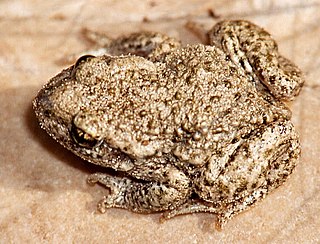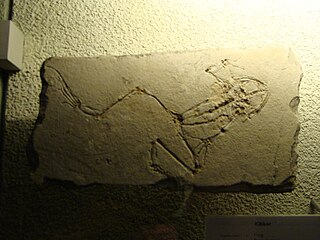
Amphibians are ectothermic, anamniotic, four-limbed vertebrate animals that constitute the class Amphibia. In its broadest sense, it is a paraphyletic group encompassing all tetrapods excluding the amniotes. All extant (living) amphibians belong to the monophyletic subclass Lissamphibia, with three living orders: Anura, Urodela (salamanders), and Gymnophiona (caecilians). Evolved to be mostly semiaquatic, amphibians have adapted to inhabit a wide variety of habitats, with most species living in freshwater, wetland or terrestrial ecosystems. Their life cycle typically starts out as aquatic larvae with gills known as tadpoles, but some species have developed behavioural adaptations to bypass this.

The Lissamphibia is a group of tetrapods that includes all modern amphibians. Lissamphibians consist of three living groups: the Salientia, the Caudata, and the Gymnophiona.

The Alytidae are a family of primitive frogs. Their common name is painted frogs or midwife toads. Most are endemic to Europe, but three species occur in northwest Africa, and a species formerly thought to be extinct is found in Israel.

Temnospondyli or temnospondyls is a diverse ancient order of small to giant tetrapods—often considered primitive amphibians—that flourished worldwide during the Carboniferous, Permian and Triassic periods, with fossils being found on every continent. A few species continued into the Jurassic and Early Cretaceous periods, but all had gone extinct by the Late Cretaceous. During about 210 million years of evolutionary history, they adapted to a wide range of habitats, including freshwater, terrestrial, and even coastal marine environments. Their life history is well understood, with fossils known from the larval stage, metamorphosis and maturity. Most temnospondyls were semiaquatic, although some were almost fully terrestrial, returning to the water only to breed. These temnospondyls were some of the first vertebrates fully adapted to life on land. Although temnospondyls are amphibians, many had characteristics such as scales and large armour-like bony plates (osteoderms) that generally distinguish them from the modern soft-bodied lissamphibians.

Triadobatrachus is an extinct genus of salientian frog-like amphibians, including only one known species, Triadobatrachus massinoti. It is the oldest member of the frog lineage known, and an excellent example of a transitional fossil. It lived during the Early Triassic about 250 million years ago, in what is now Madagascar.

Prosalirus is the name given to a fossilised prehistoric frog found in the Kayenta Formation of Arizona in 1981 by Farish Jenkins and distinguished by its hind legs for jumping The type, and currently only, species is Prosalirus bitis.

Eocaecilia is an extinct genus of gymnophionan amphibian from the early Jurassic Kayenta Formation of Arizona, United States. One species is described, Eocaecilia micropodia.

Pelophylax pueyoi is an extinct species of large frog from Late Miocene of Spain. Initially classified as a member of the "green frog" complex within the genus Rana, it has since been reclassified into the genus Pelophylax as that genus has been split from Rana.
Nevobatrachus gracilis is the only species in the extinct genus Nevobatrachus, a genus of prehistoric frogs. The original generic name of this frog was Cordicephalus Nevo (1968); however, this generic name turned out to be preoccupied by a cestode genus Cordicephalus Wardle, McLeod & Stewart (1947), which remains nomenclaturally available in spite of being considered a junior synonym of the diphyllobothriid genus Pyramicocephalus. Mahony (2019) coined a replacement name Nevobatrachus. Fossils of N. gracilis were found in a lacustrine deposit in Makhtesh Ramon called "Amphibian Hill" and it is believed they lived during the Lower Cretaceous.

Eodiscoglossus is an extinct genus of prehistoric frogs. It is known from the type species E. santonjae from the Early Cretaceous (Barremian) El Castellar Formation of Spain, as well as a referred species E. oxoniensis known from the Forest Marble Formation of the UK and an indeterminate species from the Dzunbain Formation of Mongolia. It was a small primitive frog, with a length of only 27 mm (1.1 in) from the premaxilla to the ischium. Formerly considered to be closely related to discoglossids, E. santonjae is now regarded as close to the root of the crown group of modern frogs in a position more derived than New Zealand frogs and tailed frogs, but more basal than costatans like alytids and other more advanced frogs like neobatrachians. The morphology of E. santonjae suggests a generalist and unspecialised movement habit. The referral of E. oxoniensis to Eodiscoglossus has been questioned, as it is much earlier than the type species and it is based on homoplasic and plesiomorphic characteristics inherited from a common ancestor, so there is no clear evidence of a close relation.
Iridotriton is an extinct genus of prehistoric salamander known from a fossil found in stratigraphic zone 6 of the late Jurassic Morrison Formation in the Dinosaur National Monument. One species has been described, Iridotriton hechti. It is likely a member of Cryptobranchoidea.

Liaobatrachus is a genus of prehistoric frog, the first fossil specimen of which was recovered from the Yixian Formation of Liaoning Province, China. It was the first Mesozoic era frog ever found in China. The species Callobatrachus sanyanensis,Mesophryne beipiaoensis and Yizhoubatrachusmacilentus were classified as species of Liaobatrachus in one study, but this has been rejected by other authors. The genus has been considered a nomen dubium by some authors due to the poor preservation of the holotype specimen. Fossils were found in the Sihetun locality of the western part of Liaoning province, in the lower part of the Yixian Formation, and date to approximately 124.6 Ma. Another specimen was collected near Heitizigou, 25 kilometres (16 mi) south of Beipiao. The specimen has a snout–vent length of 69 millimetres (2.7 in). Liaobatrachus is considered to be the most basal member of Discoglossidae based on phylogenetic analysis.
Rhadinosteus parvus is an extinct species of prehistoric frogs that lived during the Late Jurassic. Fossils of the species were found at the Rainbow Park site in Utah's Dinosaur National Monument, from several slabs of rock which contain multiple partial specimens, from sediments belonging to the Morrison Formation. R. parvus was likely a member of Pipoidea and may have been a member of the family Rhinophrynidae.

Trimerorhachis is an extinct genus of dvinosaurian temnospondyl within the family Trimerorhachidae. It is known from the Early Permian of the southwestern United States, with most fossil specimens having been found in the Texas Red Beds. The type species of Trimerorhachis, T. insignis, was named by American paleontologist Edward Drinker Cope in 1878. Cope named a second species from Texas, T. mesops, in 1896. The species T. rogersi and T. greggi are also from Texas, and the species T. sandovalensis is from New Mexico.
Llankibatrachus is an extinct genus of prehistoric frogs in the family Pipidae. They are known from the Ypresian (Casamayoran) Huitrera Formation of Argentina.
Enneabatrachus is an extinct genus of prehistoric frogs known from the late Jurassic Morrison Formation of the United States and also the Late Jurassic-Early Cretaceous Ksar Metlili Formation of Morocco. The type species is E. hechti, whose remains have been recovered from stratigraphic zone 5.
Thoraciliacus rostriceps is an extinct species of frog from the Cretaceous period and the only species of the genus Thoraciliacus, which is classified in the unranked clade Pipimorpha. A recent phylogenetic analysis confirmed this conclusion, and further suggested that Thoraciliacus rostriceps is more closely related to Pipidae and Shelaniinae than to Palaeobatrachus. Fossils of T. rostriceps were found in Makhtesh Ramon, Negev Desert, Israel and it is believed they lived during the Barremian. Other fossils have been found near Marydale, South Africa in an Upper Cretaceous lake.
Eobatrachus is a dubious genus of extinct frog known only from the holotype, YPM 1862, part of the right humerus, found in Reed's Quarry 9 near Como Bluff, Wyoming in the Late Jurassic-aged Morrison Formation. The type, and only species, E. agilis, was named by Othniel Charles Marsh in 1887 and he initially interpreted it as a mammal, although it was later re-classified as a genus of frog related to Comobatrachus and Eobatrachus is now seen as a dubious amphibian genus, possibly belonging to Anura (frogs) according to Foster (2007).
Susan Elizabeth Evans is a British palaeontologist and herpetologist. She is the author or co-author of over 100 peer-reviewed papers and book chapters.

Nooxobeia is an extinct genus of dissorophid temnospondyl from the Early Permian (Guadalupian) of Oklahoma. The generic name is derived from the Arapaho word nooxobe, which means frog.











